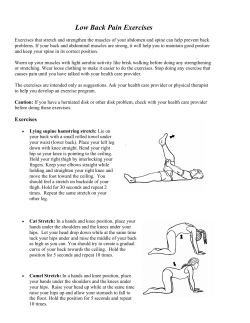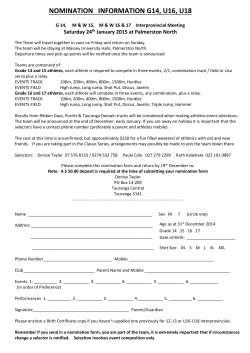
ACL Prevention and Sports Performance Program
Providence Rehabilitation Services: Keeping Athletes in the Game ACL Prevention and Sports Performance Program Help athletes reduce their risk of injury Injuries to the anterior cruciate ligament (ACL) are common knee injuries for athletes. Those most at risk are athletes who play contact sports and sports requiring sudden, swift movement. A torn ACL may require up to a year of rehabilitation. We’re happy to answer questions or attend one of your practices to give individual training sessions and team consultations. As a coach, you can help athletes significantly reduce their risk of ACL injuries. In your practice sessions, teach proper jump techniques and use the plyometric and stability exercises outlined here. These exercises can also help athletes build strength, power and sports performance. call us at 503-29-SPORT, email us at sportstherapy@providence.org or visit www.providence.org/rehab. Program specifics: n Integrate this program into your practice time. n Observe athletes to ensure they are using good form, as described for the exercises. n Follow each exercise by a 30-second rest period. Proper technique while performing exercises is vital. If technique begins to fail before the repetitions or time has been completed, stop the exercise at once. Athletes should not experience pain during exercises described in this program. If they have difficulty or cannot complete the program due to pain, they should talk with a doctor or physical therapist. Providence is the official health care provider for: Warm Up and Dynamic Stretching Instructions: Athlete should put out 50 to 75 percent effort. n Perform each exercise for 30 seconds except where indicated. n Exercises should be pain-free. Forward Jog: Slow jog on field or in gym for 1 minute Knee to Chest Walk: Pull the knee to the chest, hold for 2 seconds and release. Step forward and repeat with other leg. Backward Jog: Jog backward for 1 minute, keeping weight on the balls of the feet with knees slightly bent. Shuffle Run: Side shuffle 30 seconds each direction with knees in line with feet and back straight. When it comes to helping kids play smart, we all have a stake in the game. Walking Over/Under: Step to side with one leg as if stepping over a hurdle. Drop down into squat position; step to the same side as if ducking under a hurdle. Repeat the other direction. Monster Walk: Hold arm straight in front. Bring opposite leg toward arm. Lower. Repeat with other side. Keep back straight. Lunge with Body Twist: Perform lunge and place inside hand on foot, reaching for the sky with the other hand. Hold 2-3 seconds, then switch hands to twist the other way. Repeat with other leg. Chances are your child’s heart is healthy. Still, a small percentage of young people have hidden heart defects that put their lives at risk, especially during physical exertion. That’s why Providence Heart and Vascular Institute developed Play Smart, a heart screening program for youth. Play Smart offers free, painless, noninvasive heart screenings for young people ages 12 to 18. Screenings require a signed consent form and a completed heart-health questionnaire. To schedule a screening, please call 503-216-6800. You’ll find the consent form and medical health questionnaire at www.playsmartgetscreened.org. Plyometrics and Agility Instructions: Choose 3 or 4 exercises per session. n Perform each exercise for 30-60 seconds. n Maintain good form as described below. n Stop if pain occurs. Vertical Jump: Good symmetry = Maintain hip, knee, ankle alignment. Don’t favor one side. Landing mechanics = Land on the balls of the feet. Think ‘land soft.’ Knees bent. Stand with legs hip-width apart. Jump as high as possible. Reach up as if going for a rebound, spike or header (depending on the sport). Repeat. Tuck Jumps: Stand with feet hip-width apart. Jump and bring knees toward chest as high as possible Forward/Backward Jumps: Jump forward and backward over an imaginary line. Jump as high as possible. 180° Jumps: Scissor Jumps: Start in slight lunge position with knees slightly bent. Jump and reverse legs. Repeat. Bounding Run: Lateral Jumps: Jump side to side from a squat position. Forward leap from one foot to the other. Bring the knee toward the chest. Start in squat position. Jump off both legs and rotate body in the air. Land facing the opposite direction. Repeat, rotating back the same way you rotated from. Single-Leg Hop: Perform 10 hops forward on one leg. Jump as far as possible while maintaining good form. Repeat with other leg. Strength Instructions: Choose 3 or 4 exercises per session. n Perform each exercise for 30-60 seconds. Maintain good form as described below. n Stop if pain occurs. Front Plank: Get into plank position as shown. Keep body as straight as possible and hold position. Side Plank: Get into side plank position as shown. Keep body as straight as possible and hold position. Static Stretching Russian Hamstrings: Kneel on the ground with hands at your side and a partner holding your ankles. Lean forward while keeping the back straight. Hold 2-3 seconds. Repeat 10-15. Do this every session. Single-Leg Ball Touch: Balance on one leg. Reach down toward the outside leg or toward a ball on the ground. Repeat 10-15 times. Repeat with other side. Walking Lunges: Step forward into a lunge. The back knee should tap the ground. Repeat with other leg and walk forward, switching forward leg each step. Single-Leg Squats to Rises: Perform a single leg squat then come up on the toes. Swing opposite leg back during the squat then up toward the chest, rising up on the toes. Repeat 10-15 times each side. Instructions: Perform after each training session as cool down. n Hold each exercise 30 second, repeating each one twice. n Medium intensity only during the stretches. Hamstring Stretches: Place one foot in front of the other with legs straight. Keep hips pointed straight ahead. Reach toward front ankle. Keep knee straight to feel stretch in back of leg. Calf Stretches: Get into a sprinter’s stance. Stretch the back leg, feeling a stretch in the calf. Switch every 30 seconds. Hip Flexor Stretches: Get into half kneeling lunge position. Lean forward to feel stretch in front of the hip. Pull heel toward buttocks to increase the stretch. Quad Stretches: Grab the ankle. Bring heel toward buttocks. Keep knee pointed toward ground. www.providence.org/rehab
© Copyright 2025










